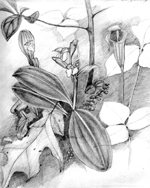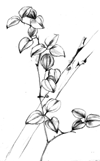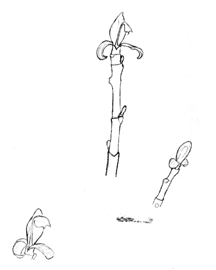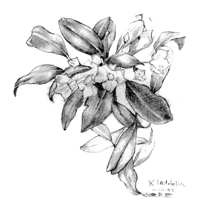Earth Journal
Spring Sketchbook
by Gary Pendleton
 When I draw from nature,
I see details, even hidden beauty, that might otherwise go unobserved. Some
of the revelations are backyard things we take for granted: the buds on
a tulip tree, native mountain laurel, commonplace greenbrier. Others are
spectacular things that bless our wild places, like the lovely Virginia
bluebell or retiring showy orchis.
When I draw from nature,
I see details, even hidden beauty, that might otherwise go unobserved. Some
of the revelations are backyard things we take for granted: the buds on
a tulip tree, native mountain laurel, commonplace greenbrier. Others are
spectacular things that bless our wild places, like the lovely Virginia
bluebell or retiring showy orchis.
Nature takes many forms, but you'll have to slow your pace to see or
seek them. Take Earth Day as a spring moment to see these wonders.
Showy Orchis
Orchids, at right, are the world's largest family of plants. The Mid-Atlantic
region is home to many species of orchid. One of  the prettiest
and most colorful is the showy orchis, with its bi-colored inflorescence
of purple and white. Because of habitat loss and over-collecting by zealous
plant lovers, the showy orchis is rarely seen in our area, at least in my
experience.
the prettiest
and most colorful is the showy orchis, with its bi-colored inflorescence
of purple and white. Because of habitat loss and over-collecting by zealous
plant lovers, the showy orchis is rarely seen in our area, at least in my
experience.
Collecting or poaching wild plants threatens their existence. It's also
pointless because the soil and habitat requirements are so particular that
orchid transplants will, almost without exception, die. Buy native plants
for your garden from reputable nurseries, and enjoy your occasional encounters
with native orchids in the wild.
I found this one growing off a path through a mature stand of woods with
Jack-in-the pulpit, spicebush and partridge berry.
Greenbrier
Greenbrier, or catbrier, (at left) is not likely to be on anyone's list
of favorite plants. However, a hooded warbler would give an enthusiastic
response. Greenbrier is closely associated with those diminutive, boldly
patterned yellow-and-black birds. The young tender growth is also preferred
by deer for food. So don't be too hasty in dismissing the humble greenbrier.
Like most native plants, it has its place in the complex web of life.
Tulip Tree Buds
 One of the most charming examples of nature in
miniature is the tulip tree bud, at right.. Now is the time to closely examine
their elegant curves. Look for one on a tree near you.
One of the most charming examples of nature in
miniature is the tulip tree bud, at right.. Now is the time to closely examine
their elegant curves. Look for one on a tree near you.
Virginia Bluebells
This early spring wildflower grows abundantly in the rich floodplain
soil of the Potomac River. It has a spray of sky-blue flowers and large,
grass-green leaves. This specimen was planted by my wife Karyn in our wildflower
garden. The day I drew it in my sketchbook, I had just finished an eight-week
program of figure drawing with live nude models. This drawing always reminds
me of a model posing.
Mountain Laurel
This native shrub, at left, is also popular in the home landscape. It
grows throughout our region, from the mountains to the coastal plain in
well-drained acidic soil. Like blueberries, azaleas and rhododendrons, it
is a member of the heath family.
| Issue 16 |
Volume VII Number 16
April 22-26, 1999
New Bay Times
| Homepage |
| Back to Archives |
 When I draw from nature,
I see details, even hidden beauty, that might otherwise go unobserved. Some
of the revelations are backyard things we take for granted: the buds on
a tulip tree, native mountain laurel, commonplace greenbrier. Others are
spectacular things that bless our wild places, like the lovely Virginia
bluebell or retiring showy orchis.
When I draw from nature,
I see details, even hidden beauty, that might otherwise go unobserved. Some
of the revelations are backyard things we take for granted: the buds on
a tulip tree, native mountain laurel, commonplace greenbrier. Others are
spectacular things that bless our wild places, like the lovely Virginia
bluebell or retiring showy orchis. the prettiest
and most colorful is the showy orchis, with its bi-colored inflorescence
of purple and white. Because of habitat loss and over-collecting by zealous
plant lovers, the showy orchis is rarely seen in our area, at least in my
experience.
the prettiest
and most colorful is the showy orchis, with its bi-colored inflorescence
of purple and white. Because of habitat loss and over-collecting by zealous
plant lovers, the showy orchis is rarely seen in our area, at least in my
experience.
 One of the most charming examples of nature in
miniature is the tulip tree bud, at right.. Now is the time to closely examine
their elegant curves. Look for one on a tree near you.
One of the most charming examples of nature in
miniature is the tulip tree bud, at right.. Now is the time to closely examine
their elegant curves. Look for one on a tree near you.